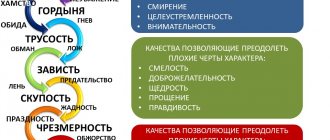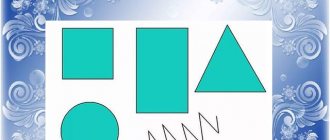Temperament is a set of mental and physiological traits of a person that determine the nature of his reactions to external stimuli. The latter includes everything around us: other people, animals, events, circumstances, etc.
In the Unified State Examination in social studies, temperament is a headache for all test takers. True, they do not realize this, but understand only after passing the exam. To avoid having your scores lowered on this topic, you need to clearly understand what temperament is? In this article, briefly and in simple words, we’ll talk about just that!
By the way, before reading this article, I recommend the articles: what is personality and about the concept of individuality, human personality.
Currently, science has moved from studying types of temperament to studying its properties. The selection of properties is carried out on the basis of criteria, signs of temperament (V.M. Rusalov):
1) temperament expresses the formal-dynamic nature of behavior (it is not related to the content of the activity and determines the dynamics of the activity);
2) temperament is associated with biological substructures;
3) it is genetically determined, primary;
4) manifests itself early in childhood;
5) temperament is ontogenetically stable, that is, it is stable over certain periods of time. It is the result of development, not education;
6) temperament is cross-situational, that is, it manifests itself in a wide class of situations. It can be studied in various activities;
7) temperament manifests itself more clearly in the most difficult conditions for a person.
Temperament properties are inherent in all people, but with varying degrees of development. In modern psychology, 8 properties are distinguished (BC Merlin, B.M. Teplov, V.D. Nebylitsin): sensitivity, activity, reactivity, balance of activity and reactivity, rate of mental reactions, plasticity-rigidity, emotional excitability, extraversion-introversion.
Sensitivity is a general persistent feature of the nervous system and analyzers, which is expressed in general sensitivity (excitability of attention). It is determined by the strength of the external influence that causes a mental reaction (high sensitivity of the senses, as well as high sensitivity to ongoing events - empathy, anxiety, vulnerability. High sensitivity in melancholic people.
Activity – the degree of energetic influence on the outside world, overcoming obstacles (volitional component). High activity in choleric, sanguine and phlegmatic people and low in melancholic people.
Reactivity – impulsiveness, involuntary movements, reactions to external and internal influences. Manifests itself in the pace, strength and form of response to events. High reactivity in choleric and sanguine people and low in phlegmatic and melancholic people.
The balance of activity and reactivity is determined by what human activity is more dependent on: random, external (mood, random events, etc.) or internal (determination, beliefs, etc.) factors. Sanguine and phlegmatic people are balanced, while choleric and melancholic people are unbalanced.
The pace of mental reactions is the speed of mental processes (movements, speech, perception, etc.). The tempo is high for choleric and sanguine people, low for phlegmatic and melancholic people.
Plasticity - rigidity - the degree of adaptation of a person to changing circumstances and activities.
Plasticity – flexibility, ease of adaptation to new conditions. Sanguine and choleric people are plastic.
Rigidity (lat. rigiditas - hardness) - inertia, inertia in adapting to new conditions, insensitivity to their changes. Phlegmatic and melancholic people are rigid.
Emotional excitability is the reaction time to emotionally significant and neutral stimuli. How weak influences are necessary for the emergence of emotions and the speed of their occurrence. Emotional excitability is high in melancholic and choleric people, low in sanguine and phlegmatic people.
Extraversion-introversion is the direction of mental activity outward or inward.
Extroversion is an individual personality trait, manifested in the predominant focus of consciousness on the world around us, in increased sociability, initiative, social adaptability, interest in other people, and openness of the inner world. Extroverts are choleric and sanguine.
Introversion is a person’s focus on himself, on his inner world, on his own actions, actions, experiences and thoughts. It manifests itself in unsociability, isolation, lack of interest in others and a tendency to in-depth introspection. Introversion is one of the basic personality traits. Introverts are phlegmatic and melancholic.
How to determine a person's temperament
The most reliable way to determine your own temperament type is to take one or more tests (to control and compare results). The test of Eysenck, a famous specialist in the field of psychology, creator of the factor theory of personality, based on the types of people’s temperaments, is very popular. The test consists of 40 questions and is used by both amateurs and professional psychologists. There are tests designed specifically for parents - with their help you can determine the temperament of a child 3-4 years old and older.
The situation becomes more complicated if you need to clarify the temperament of other people who, for some reason, cannot be asked to take the test. In such cases, psychologists recommend focusing on external manifestations characteristic of 4 temperaments:
- Sanguine
. Sociable, talkative, easily becomes part of new companies, finds a common language with previously unfamiliar people. Has expressive facial expressions, actively gesticulates, but facial expressions and gestures do not look sharp or impetuous. Walks quickly but smoothly. Usually has good posture. - Choleric
. It can be incendiary, captivating, or, on the contrary, irritable and rude. Gives the impression of imbalance due to short temper and frequent mood swings. He is sociable, talkative, and due to his expressed emotionality, sometimes “pulls the blanket” over himself, not allowing his interlocutor to speak. He speaks quickly and sharply, has expressive, bright facial expressions, and violent gestures. Movements are sharp and jerky. - Phlegmatic
. Slow, calm, unhurried. He speaks little and to the point, does not like empty chatter. Shows little emotion, gesticulates little. Despite the external inexpressiveness of speech and gestures, he has rich facial expressions. Moves smoothly, unhurriedly. Regardless of build and type of activity, he usually gives the impression of a solid person who stands firmly on the ground. - Melancholic
. Among strangers and in noisy companies, he tends to be passive, silent and inconspicuous. Often avoids new people. In a comfortable environment or alone with a person he likes, he relaxes and opens up. Strong emotions are combined with weak gestures. Can move quickly or slowly, but movements are always restrained. Very observant.
Phlegmatic - characteristics: pros and cons
If we talk about the psychological component of sanguine people, then in these people the degree of excitement in the central nervous system is quite high. On the contrary, the inhibition threshold is low, and therefore sanguine people perceive the world in a somewhat illusory way. But at the same time, thinking and memory functions are remarkably developed. Often sanguine people focus their memory only on what arouses their interest.
The emotional background of sanguine people is quite diverse. These people are emotional and are not afraid to show their experiences to others. They often gesture when talking, and may hug or kiss when meeting. These emotions are completely sincere; a sanguine person wants to please people and receive the same reaction from them in return.
People with this type of temperament have a lot of friends. A sanguine person knows how to make friends, and always comes to a person’s aid in a difficult situation. In personal relationships, sanguine people are sometimes flighty. An excessive thirst for communication prevents them from building a strong family.
- Inconsistency in actions and deeds. A sanguine person often gets down to business, but rarely completes it; such people cannot work in monotonous work;
- Sanguine people often overestimate themselves and their capabilities;
- People with a similar temperament have mood swings, it is difficult for them to develop strong-willed qualities;
Psychologists recommend that sanguine people work more on their willpower. Pay attention to little things, learn to rely on your own strengths.
- They are often not receptive, do not take initiatives, and react poorly to external stimuli;
- They may be stingy with emotions, slow to get involved in work, and have poor contact with people around them;
- Difficulty adapting when changing living conditions;
Psychologists recommend that phlegmatic people be active people and avoid lethargy and laziness.
- Emotional instability, indecisiveness, lack of self-confidence and strength;
- Difficulty with the perception of the surrounding world, vulnerability, pessimism;
- Tendency to depressive mental states;
Psychologists strongly recommend that melancholic people not close themselves off. Try to explore the world, travel, communicate with new people. You can try mentoring to improve your personal self-esteem. Engage in active sports, dancing, any creativity. A melancholic person needs to be close to loved ones and friends, and not withdraw into himself and his feelings.
Take a temperament and extroversion/introversion test
Phlegmatic friend
Melancholic at work
Melancholic friend
- Makes friends with caution
- Prefers to stay in the shadows
- Tries not to attract attention to himself
- Devoted and faithful
- Ready to listen to complaints
- Can solve other people's problems
- Concerned about other people
- Looking for the perfect partner
Types of temperament and character in psychology and business
In addition to the classical system of dividing temperaments, there is another one, which is often used in business. With its help, you can form a team that will successfully achieve your goals.
“Depending on their temperament, people are assigned a certain color,” notes Maria Roshchina. “Based on your color, you can judge what type of activity is ideal for you.”
- Yellow . People of this color are called interested. They are kind, friendly, caring. They are often characterized by shockingness and a penchant for creativity. In a team, they become the “sun” to which everyone else is drawn.
- Blue . Such people know how to work and relax. They have excellent analytical skills, so they quickly find errors and can direct the project work in the right direction. In their free time, they are true party people, they easily switch their attention from office routine to relaxation and know how to relax.
- Reds . These are born leaders, ready to go above and beyond and move any project forward like a powerful locomotive. They are aggressive in their work and decisions, and are often not inclined to listen to other people’s opinions, since they always know what is best, what is right and what to do next.
- Greens . In the team they may be considered nerds and quietly laugh at them. But no one will doubt their value as employees. These are excellent performers, diligent, always finishing everything. At the same time, they are non-conflict, kind and responsive, and therefore are able to win over anyone.
“When creating a team, put the “red” at the head,” advises psychologist-coach Maria Roshchina. “He will move forward like a locomotive and will take the team to a new level. Then it’s the Blues’ turn. Several of these employees will analyze and find mistakes made by the “red” ones and will not allow the project to go off the intended “rails”. “Yellow” is also needed, this is the “firefly” in the team to which everyone is drawn. He plays the role of a motivator. And recruit as many “green” — diligent performers — as possible. This way, your team will be properly staffed and produce results.”
pixabay.com/
How to use knowledge about temperament to your advantage
Information about temperament brings practical benefits in many areas of life. Knowing your own temperament, you can more accurately determine your capabilities, strengths and weaknesses, and the vector of applying effort to master new skills or compensate for shortcomings. Knowing the child’s temperament, you can choose the most effective methods of education, adjust the requirements and help in choosing a profession. Knowing the temperament of other people helps to understand them better, be more flexible in contact, more clearly define the strategy of one’s behavior, and adapt to someone else’s style of communication.
Experts in the field of psychology say that representatives of all four types of temperaments can be given general recommendations to compensate for shortcomings:
- A choleric person should take into account that his activity sometimes becomes destructive.
- Sanguine - that when solving important issues it is worth being more serious.
- Phlegmatic - that it is necessary to show more speed and flexibility.
- To a melancholic person - that ordinary failures, troubles and mistakes are not a life disaster.
There are recommendations for organizational work and communication with people, taking into account their temperament:
- Choleric - “get busy.”
The activity of a choleric person can bring rich fruits if directed in a constructive direction. A choleric person who is idle and bored may begin to become distracted or do something destructive. The best option is to let a person choose an activity for himself; this is usually not difficult for an idea generator to do. - Sanguine - “trust, but verify.”
Sanguine people value the good attitude of other people; trust is important to them. They can be given complex tasks that require significant effort, and expect good results. At the same time, they should be unobtrusively controlled, because sanguine people can promise something so as not to offend, and then not fulfill the promise because it became uninteresting or they didn’t want to from the very beginning. - Phlegmatic – “don’t rush.”
It is useless to force a phlegmatic person to do so; he is most productive when he works at his own pace. Phlegmatic people usually calculate well the time and effort required to solve a problem, so if a person has taken on something, there is no need to knock him down. How to expect to quickly switch between different tasks. - Melancholic – “do no harm.”
Melancholic people react sharply to negative emotional signals from others; it is better to communicate with them tactfully and with restraint, not forgetting to praise for successes and not bringing shortcomings to public discussion.
Temperament determines methods of action, but not their effectiveness. Representatives of different temperaments can achieve success in the same area, but do it in different ways. Understanding temperament helps a person find his path and go through it with less effort, but with better results.









